Side Menu:
Second Officer C.H.Lightoller
- World War One
World War I also known as the First World War or the Great War began on the 28th of July 1914 and lasted until the 11 November 1918. During this time, only two years after the Titanic disaster, Lightoller was involved in 5 dramatic events including a further two sinkings.
1. The Oceanic - the Secret Wreck
From the 1st of June 1914, Lightoller served aboard the RMS Oceanic as First officer. When the RMS Oceanic was requisitioned as an armed merchant cruiser with the outbreak of war, Lightoller, as an officer in the RNR, went from first officer to first lieutenant, explaining “I was promoted to First Lieutenant and Mary of the Messdecks”(47.). This was not only a change in job title, as he explains in his book:
"Forcing the Merchant Service man into Navy ways was almost as hard as making water run uphill. Yet, such is his adaptability, that within a few months of was he clicked his heels and turned to the right about, with the best. In fact, when the war was over, and we were back again in our own happy and respective spheres it took him some time to quit clicking his heels—and get some work done.”(47.)
Although officially listed as serving aboard the Oceanic until the 14th of August 1914, he actually served until the 8th of September 1914. The difference is due to the fact that the Oceanic ran aground during wartime in a non-war related incident which would have been an embarrassment for a country at war and so was kept secret.
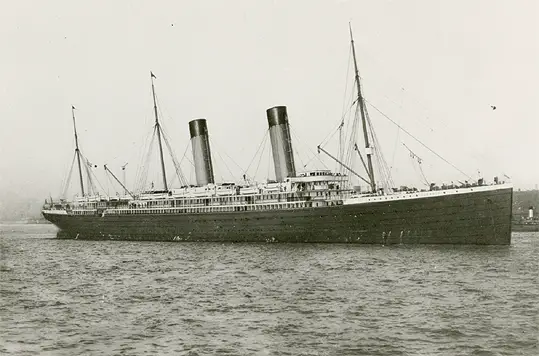
RMS Oceanic, aboard which Lightoller where he returned in the capacity of first officer.
(Click image to enlarge)
The 17,000 tonne, 700 feet long HMS Oceanic had been sent to the northern waters off the coast of Great Britain, patrolling the Scottish coast and the Faroe and Shetland Islands. waters that were riddled with reefs and difficult passages. Disaster struck on September 8th, 1914 when David Blair, the officer who had been aboard Titanic as second officer, but was removed when Chief officer Wilde caused a reshuffle days before sailing, tried to steer the ship safely near Foula Island (of the Shetland Islands) during a heavy fog. Due to an apparent navigational error, the HMS Oceanic ran into the hidden reefs of the notorious Shaalds of Foula. Lightoller, off duty at the time when the collision occurred, sprang into action and found himself once again directing the loading of lifeboats to save persons from a doomed ship. All persons aboard, more than 600 individuals, were carried to safety. The Oceanic remained stranded on the reef for three more weeks until a vicious storm swept it off, sinking it into the sea. It was a sad demise for Lightoller, as the Oceanic held a special place in his heart:
“I was never so fond of any ship as the Oceanic, either before or since, and her loss was like the snapping of the last link that held me to the Merchant Service and the White Star Line.”(47.)
2. The Campania - First Aircraft Carrier
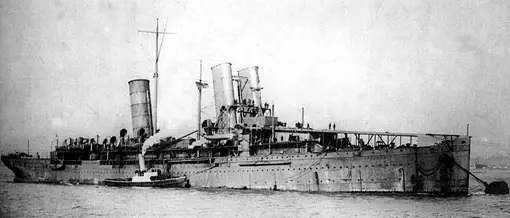
HMS Campania - modified from an ocean liner into an aircraft carrier with a short flight deck.
While awaiting his next assignment, Lightoller assumed a position patrolling the southwest British coast in a fishing trawler, disguised in fisherman’s garb. Then in 1915 he served as the first officer during the trials of another former passenger liner, RMS Campania, which had just been converted into an aircraft carrier and positioned in the North Sea.
The Campania was an aging 13,000-ton ship which had previously sailed for the Cunard Line but had been given a new lease of life as one of the first aircraft carriers of the war. Pioneering as it was, the flight deck was rather short at 160 ft (49 m) at the front of the shipand many of the Short 184 seaplanes that were taking off from its deck found themselves in the sea. Lightoller even found himself in the observer’s cockpit aboard the Short 184 seaplane, scanning the Atlantic for enemy ships and U-boats, but also ending up in the sea when the planes failed to manage a take off from the short flying deck. However he also ended up being the first observer to spot enemy ships from the air, his wireless message was allegedly not received and they lost their position and only just made it back as the engine spluttered on empty.
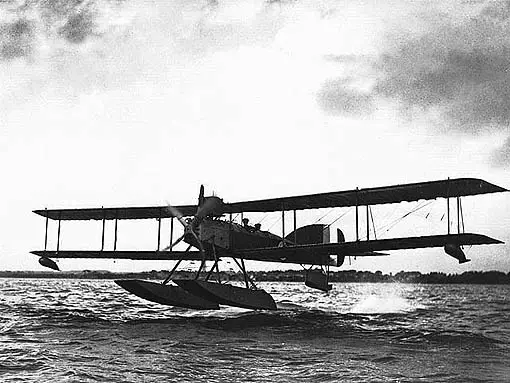
Short Type 184 seaplane Lightoller was in as an observer.
3. HMTB 117 - the Torpedo and the Zeppelin
On the 14th of September, 1915 the Lightoller family welcomed another addition to the family - with the birth of Claire Doreen. Also in late 1915, Lightoller was given his own command of a torpedo boat the HMTB 117 which was part of the Nore Defence Flotilla and he was by accounts a popular captain.
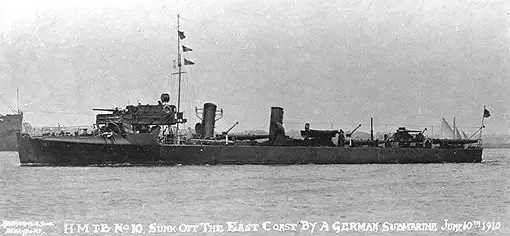
A HMTB torpedo boat similar to the 117 Lightoller commanded.
On July 31, 1916, he had an encounter with the German Zeppelin L31 and they were engaged in a prolonged night battle. He ambushed the ship at the mouth of the Thames Estuary, possibly stopping the airship from bombing London. With the Zeppelin right overhead, they fired at it with their Hotchkiss guns. Three shots hit the Zeppelin, but unbelievably the airship was not punctured. The Zeppelin responded with a steady stream of bombs that came pouring down, exploding in the water but fortunately not hitting the 117. With that, the zeppelin headed away, and the confrontation ended. With the airship’s payload expelled, London would be spared a potential bombing. The men of the 117 had no way of knowing it, but this particular zeppelin was the L31 under the command of Heinrich Mathy, recognized as Germany’s foremost zeppelin commanders. The ship itself was one of the largest and newest in this enemy’s fleet. The battle ultimately ended with Lightoller receiving the Distinguished Service Cross for his efforts, on the 23rd of May 1917.(61.)
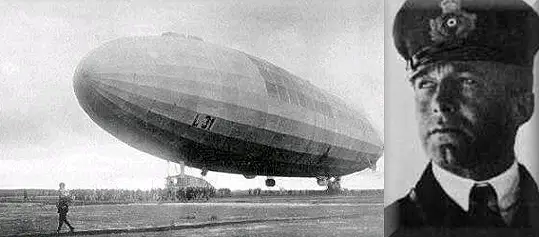
32 year-old Capitanleutnant Heinrich Mathy and the German Zepplin L31. Lightoller received a Distinguished Service Cross by thwarting an attack on London
on July 31st, 1916.
4. Falcon -Another sinking
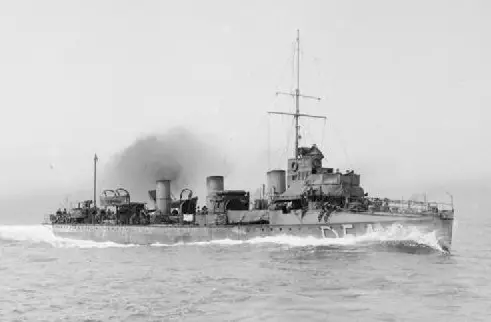
Lightoller became captain of the HMS Falcon
In 1916 Lightoller was appointed captain of HMS Falcon, a Fairfield three funnel, 30 knot C-class torpedo boat destroyer ordered by the Royal Navy under the 1898 – 1899 Naval Estimates and for the next two years Lightoller served with the Falcon on the "Dover patrol". During this time, Herbert and Sylvia lived at 8 East Cliff in Dover while he was attached to the Dover Patrol.
By the end of 1917 the Dover patrol had managed to transport food, supplies, and more than 5,000,000 British troops to the western front of the war and to return with soldiers who had been injured during the conflict, all without a single ship being lost in the process. That was until April 1st 1918, when the Falcon was sunk after a collision with a trawler, the John Fitzgerald, in fog, while Lightoller was captain. Neither was the first incident; the Falcon had earlier been involved in a collision while docking in Dover Harbour, with heavy seas making it a difficult task and a nervous sailor, responding to Lightoller's order for 'full speed astern' accidentally throwing the handles to full speed forward instead. They collided with the transport ship Accrington and although the damage was reasonably minor it required a week's worth of repairs.(61.)
But on April 1st, 1918, the Falcon was accompanying a convoy to Norway and was starting its trip back to the Humber Estuary at Hull when the armed trawler HMS John Fitzgerald, a fishing trawler helping with the convoy, collided with the Falcon. The Trawler had hit her narrow hull amidships nearly cutting her in two. For the third time in his career as a ship’s officer, Lightoller found himself involved with evacuating a sinking ship.
The crew, with the exception of captain Lightoller, the first lieutenant and the gunnery officer were evacuated in the ship's boats (one stoker died during the night of injuries sustained from scalding).
The fore-part of the ship broke away and sank shortly after midnight, leaving the three officers marooned in the stern, which sank at 02.15. The officers were rescued by a trawler, the HMS Peterel, after half-an-hour in the water. The loss was particulary acute for Captain Lightoller as his decision to take advantage of the Falcon’s extra cargo space turned out to be a terrible mistake: the Lightoller’s were preparing for a move to a new home along the Humber, and every piece of the family’s furniture had gone to the bottom of the ocean when the Falcon sank.(61.)
In April 1918 Lightoller was eventually exonerated in a court martial for the loss of the HMS Falcon.
5. Garry - U-boat Controversy
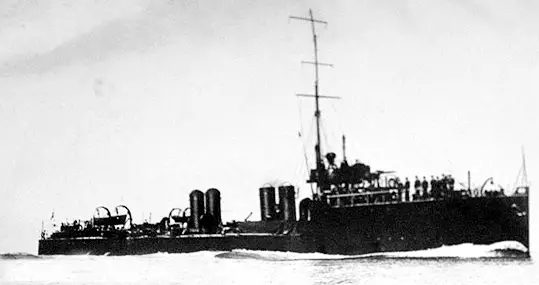
HMS Garry was a Yarrow-type River-class destroyer of the Royal Navy
In 1918 Lightoller was subsequently given command of the large River-class destroyer HMS Garry. It was smaller than the Falcon but better armed and tasked with guarding the North Sea conveys from U-boat attacks. He was apparently nicknamed "Lucky Lights" after escorting six consecutive convoys averaging 40 ships each with only one loss. But his luck was about to run out. Also during 1918, the Lightoller's youngest son, Herbert Brian, was born.
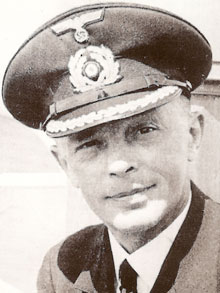
U-boat commander Werner "Fips"
Fürbringer (2 October 1888 – 8 February
1982) accused Lightoller's crew of
opening fire with revolvers and
machine guns on the unarmed
survivors after the sinking of UB-110.
On the 10th of June 1918, Lightoller was awarded the Reserve Decoration and then nine days later, on the 19th, the HMS Garry, under Lightoller's command depth charged, rammed and sunk the German U-Boat UB-110, under the command of Kapitänleutnant Werner Fürbringer, off the Yorkshire coast, near the Tyne. The Garry, having manoeuvred for offensive action, came up with UB-110. Her helm was put over and she rammed the German submarine amidships, ripped her open and sank her. There were no survivors of the crew of the UB-110, who numbered 36 all told, but the captain Werner Fürbringer survived. The damaged Garry limped home, and Lightoller subsequently faced criticism over the fact that the crew of the Garry had thrown coal at the survivors of the U-boat and that Lightoller had made no real effort to pick up any of the enemy sailors, he argued that he was more occupied by concerns for his own ship. In 1936 the captain of UB-110 claimed that Lightoller had continued to fire upon members of his crew as they surrendered, killing and spraying machine gun fire onto the hapless men.
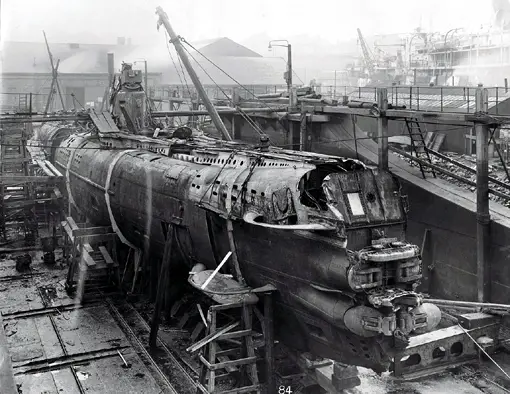
U.B. 110 before she was scrapped, in the dry docks of
Swan Hunter Wigham Richardson Ltd, Wallsend.
Lightoller's ill feeling towards the U-boat crew is even expressed in his autobiography, where he does not deny the claims but writes: “Towards the submarine men, one felt an utter disgust and loathing; they were nothing but an abomination, polluting the clean sea.”
In his postwar memoirs, Fürbringer alleged that, after the sinking, the HMS Garry hove to and opened fire with revolvers and machine guns on the unarmed crew in the water. He states that he saw the skull of his 18-year old steward split open by a lump of coal hurled by a member of Garry's crew. He also states that when he attempted to help a wounded officer to swim, the man said, "Let me die in peace. The swine are going to murder us anyhow." The memoir states that the shooting ceased only when the convoy that the destroyer had been escorting, and that contained many neutral-flagged ships, arrived on the scene, at which point "as if by magic the British now let down some life boats into the water." (Werner Fürbringer (1999), Fips: Legendary German U-Boat Commander, 1915-1918, Naval Institute Press, Annapolis. Pages 118-121.)
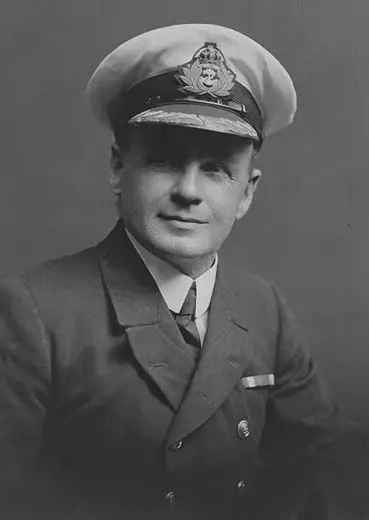
An undated image of Lightoller in uniform.
(Click to enlarge)
21 out of 34 crew members were killed during the sinking and alleged masscre, and Fürbringer was captured. He spent the rest of the war as a British prisoner of war. Ultimately it ended well for Lightoller, earning himself another medal as he was awarded a bar to add to his Distinguished Service Cross, and he was promoted to Lieutenant-Commander. A year later, on July 14, 1919, Lord Sterndale and the Prize Court awarded ₤180 as a bounty for the action they had taken and for the death of 36 German sailors. The money, distributed among the Garry's crew, is equivalent to five pounds for every member of the Kriegsmarine drowned in the incident.
With the First `World War officially finishing on the 11th of November 1918, Lightoller was placed on the retired list on the 31 March 1919, with the rank of Commander.